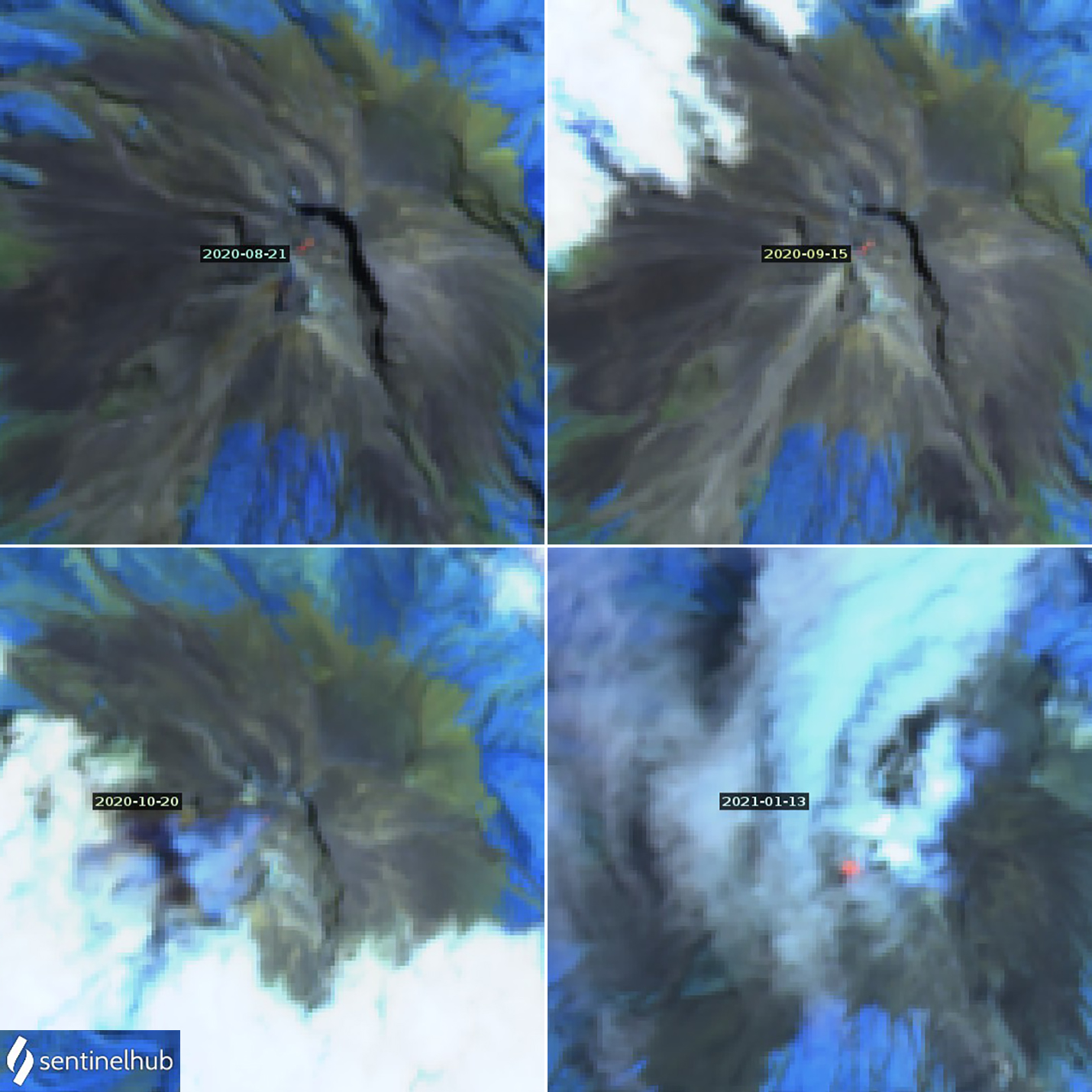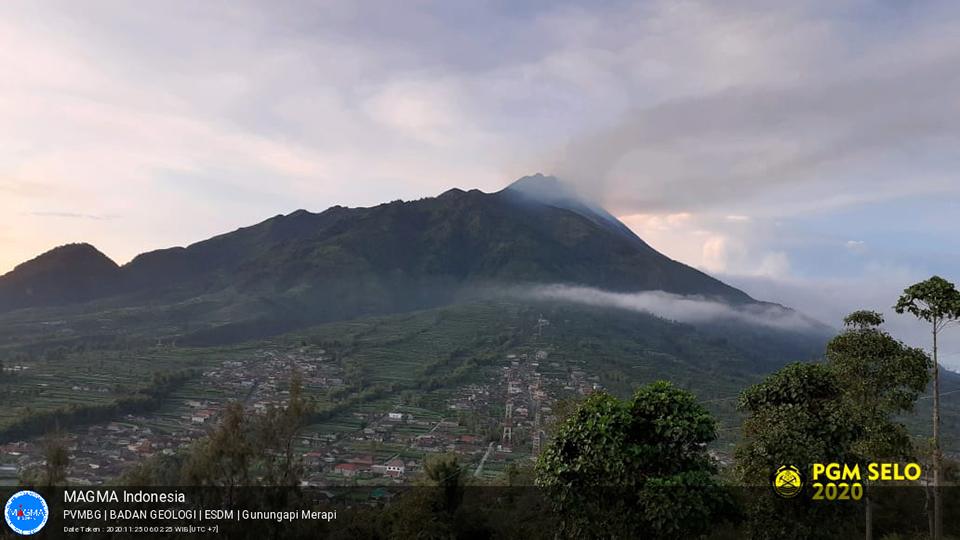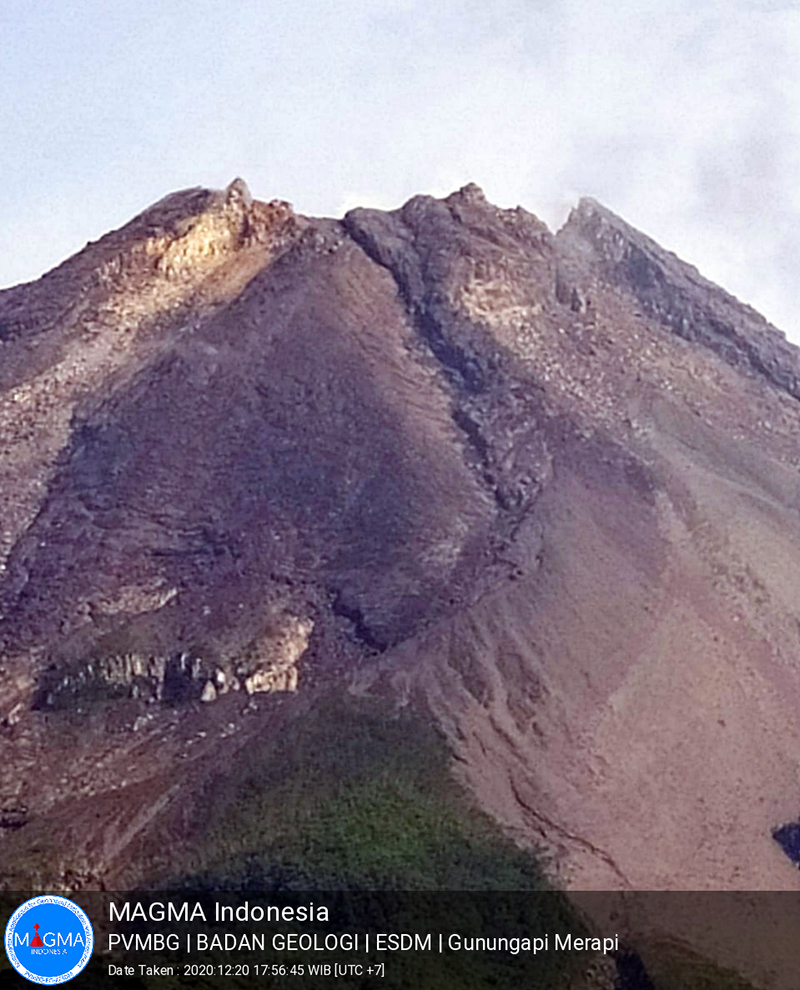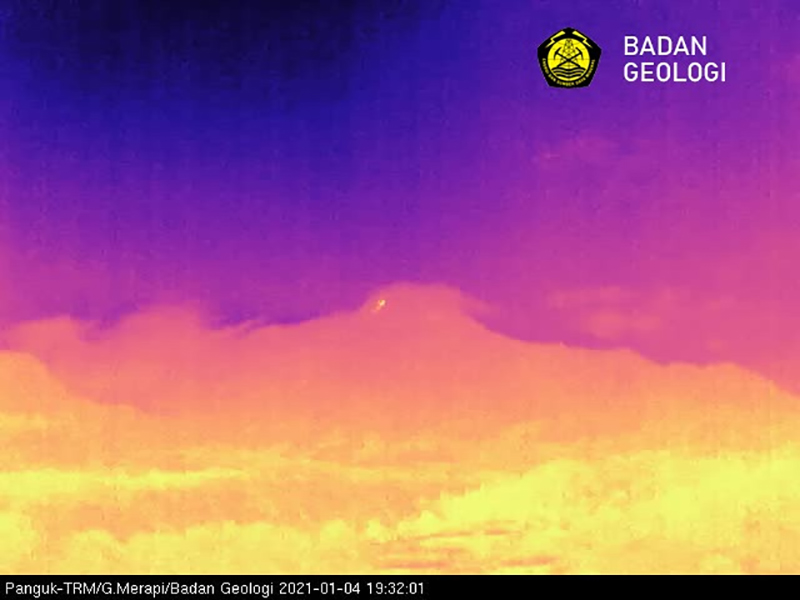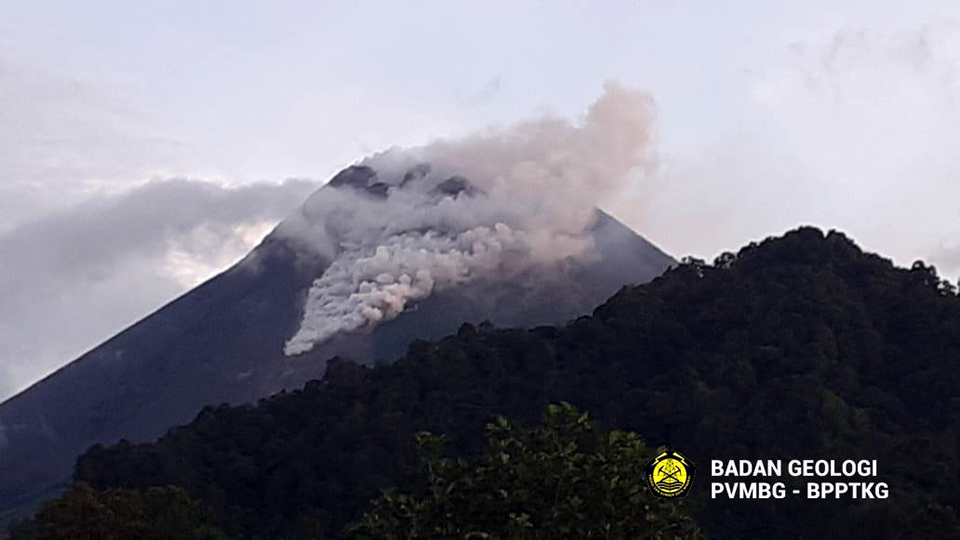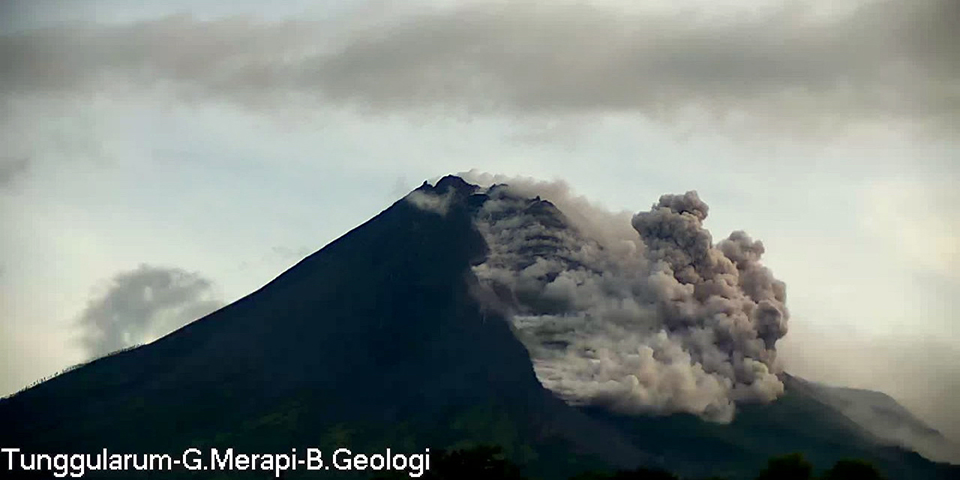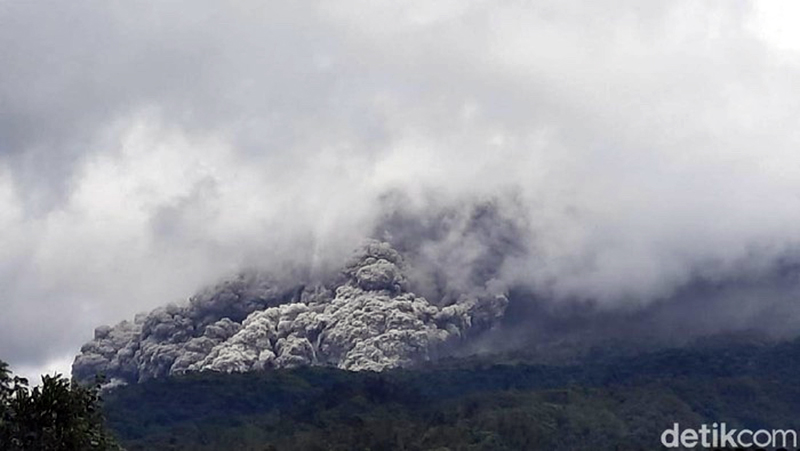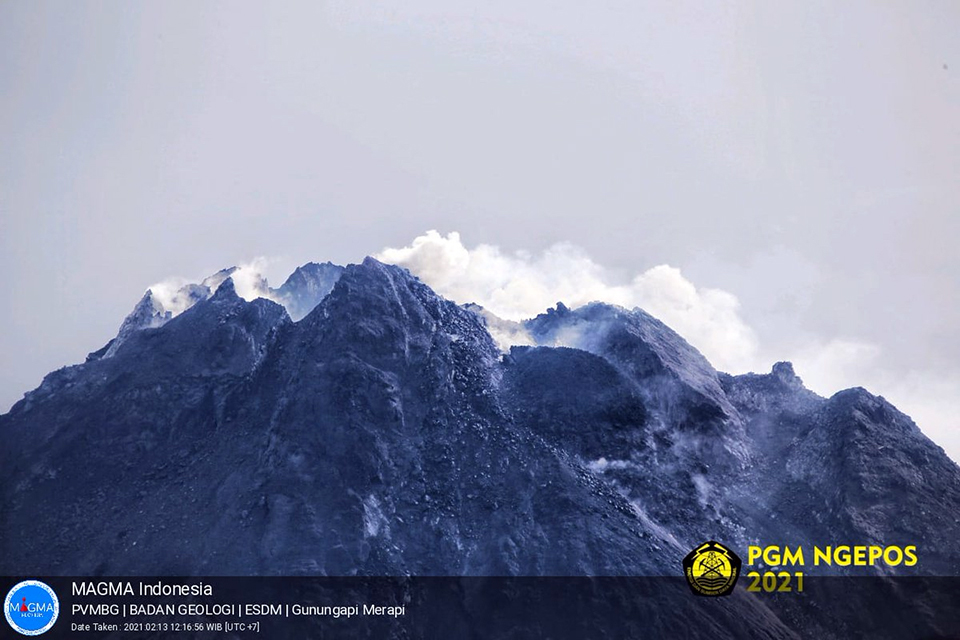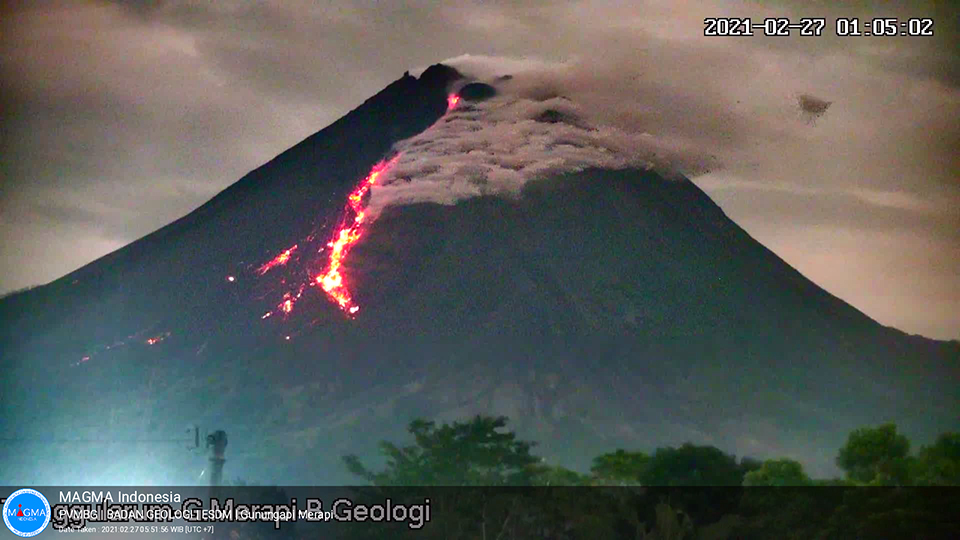Report on Merapi (Indonesia) — March 2021
Bulletin of the Global Volcanism Network, vol. 46, no. 3 (March 2021)
Managing Editor: Edward Venzke.
Edited by A. Elizabeth Crafford.
Merapi (Indonesia) New domes appear in January and February 2021; large explosion on 27 January
Please cite this report as:
Global Volcanism Program, 2021. Report on Merapi (Indonesia) (Crafford, A.E., and Venzke, E., eds.). Bulletin of the Global Volcanism Network, 46:3. Smithsonian Institution. https://doi.org/10.5479/si.GVP.BGVN202103-263250
Merapi
Indonesia
7.54°S, 110.446°E; summit elev. 2910 m
All times are local (unless otherwise noted)
Merapi volcano in central Java, Indonesia, has a lengthy history of major eruptive episodes. Activity has included lava flows, pyroclastic flows, lahars, Plinian explosions with heavy ashfall, incandescent block avalanches, block-and-ash flows, and dome growth and destruction. Fatalities from these events were reported in 1994, 2006, and in 2010 when hundreds of thousands of people were evacuated. Renewed phreatic explosions in May 2018 cancelled airline fights and generated significant SO2 plumes. A new lava dome appeared in early August 2018; gradual dome growth and then destruction was accompanied by rockfalls, block-and-ash flows, periodic explosions, and pyroclastic flows through June 2020. The period from October 2020 through February 2021 is covered in this report and includes the growth of two new domes in early 2021. Information is provided primarily by Balai Penyelidikan dan Pengembangan Teknologi Kebencanaan Geologi (BPPTKG), the Center for Research and Development of Geological Disaster Technology, a branch of PVMBG, which monitors activity specifically at Merapi, the Pusat Vulkanologi dan Mitigasi Bencana Geologi (PVMBG, also known as Indonesian Center for Volcanology and Geological Hazard Mitigation, CVGHM), and the Darwin Volcanic Ash Advisory Centre (VAAC).
Measurements in late July 2020 showed no change in the dome (BGVN 45:10), though satellite evidence for weak thermal activity near the NW crater rim persisted during August-October 2020 (figure 98). A significant increase in the deformation rate and the appearance of numerous rock avalanches at the end of October led PVMBG to raise the Alert Level from II to III and evacuate hundreds of local residents. During November and December 2020 the deformation rate continued to increase and numerous rock avalanches were reported. Incandescent block avalanches were first reported on 4 January 2021. Block-and-ash flows began on 7 January and increased in frequency throughout the month; a new dome was confirmed that day. The deformation rate decreased significantly as the dome grew in size during January. Hundreds of incandescent block avalanches were recorded through the end of the month. A large explosion on 27 January produced a 12.2-km-high ash plume and a large pyroclastic flow; ashfall was reported in numerous communities. Incandescent block avalanches and block-and-ash flows continued frequently during February 2021; a second dome was reported growing near the center of the summit crater on 17 February.
The deformation rate at the summit, shortening determined by Electronic Distance Measurements (EDM) interpreted by PBBTK as inflation related to magma moving towards the surface, remained between 1-2 cm per week during August through early -October with just steam-and-gas plumes rising 150-250 m. During the week of 9-15 October PBBTKG reported a deformation rate of 1 cm/day. Drone photographs confirmed no change in the size or shape of the dome on 18 October 2020. The shortening rate increased to 2 cm/day during 16-22 October and the steam-and-gas plumes rose up to 500 m above the summit; the shortening rate increased to 4 cm/day during 23-29 October. PVMBG reported on 28 October that rock avalanches were heard twice in Babadan and Jrakah over the previous 24 hours, but fog prevented observations.
PVMBG raised the Alert Level from II to III on 5 November 2020 based on an increase in both seismicity and the deformation rate. Rock avalanches were heard that day from Babadan. Analyses of the crater area based on photographs from 30 October and 3 November did not show any morphological changes at the dome. The shortening rate, however, increased to 9-10 cm/day during the first three weeks of the month. Rock avalanches were observed on 8 November on the W flank moving as far as 3 km downslope and moving 2 km on 14 November. Photos comparing the SE flank on 11 and 19 November showed that part of the 2018 lava dome had collapsed. Drone images on 16 November also showed a collapse of part of the crater wall. On 22 November rock avalanches from the crater rim moved 1 km down the W flank. Steam and gas emissions were observed from the Babadan Observation Post rising 200-750 m above the summit during the second half of November (figure 99. A photo analysis on 26 November indicated that part of the 1954 lava dome had collapsed since 19 November. The deformation rate had increased to 11 cm/day by the last week of the month. During overflights on 26 and 27 November BNPB and BPPTKG observers noted many new avalanche deposits on the NW, W, and SW flanks. As of 27 November, there were 2,318 people who had been evacuated from the area around the volcano.
Steam and gas plumes rose 150-400 m above the summit throughout December 2020. Rock avalanches were heard but not seen due to foggy weather during the first few days of the month. On 8 December they were seen falling 200 m upstream of Kali Lamat on the W flank and on 14 December they were observed moving downslope 1.5 km on the NW flank upstream of the Senowo River. Rock avalanches were also observed on 23 December moving 1.5 km down the W flank above Kali Sat ravine and on 31 December moving the same distance above the Senowo River. The deformation rate remained high during December, ranging from 9-11 cm/day through 24 December; it rose to 14 cm/day during the last week. Minor changes were seen in photographs of the summit area, but drone data on 5 and 14 December showed no new lava dome. No lava dome was visible in a clear view of the upper part of the SW flank on 20 December (figure 100); the head of BPPTKG-PVMBG noted that the first observed incandescence in that area was on 31 December.
The deformation rate remained very high at 15 cm/day during the first week of January 2021. Rock avalanches were observed on 1 and 3 January that moved 1.5 km from the summit towards Kali Lamat and Kali Senowo on the W and NW flanks. On 4 January incandescent material was observed with a thermal webcam, and rock avalanches were heard at the Babadan Observation Post (figure 101). Incandescent block avalanches were observed 19 times during 4-7 January, traveling 800 m to the upper reaches of Kali Krasak (figure 102). Four block-and-ash flows occurred on 7 January, moving less than 1 km downslope. Comparison of images between 24 December and 7 January revealed a new lava dome. Hanik Humaida, the head of BPPTKG-PVMBG concluded that incandescent lava had appeared at the bottom of the 1997 dome and noted that incandescence had first been observed late on 31 December. PVMBG issued VONAs on 7 and 9 January reporting block-and-ash flows that produced ash plumes which rose to 3.2 km altitude and drifted SW and NW.
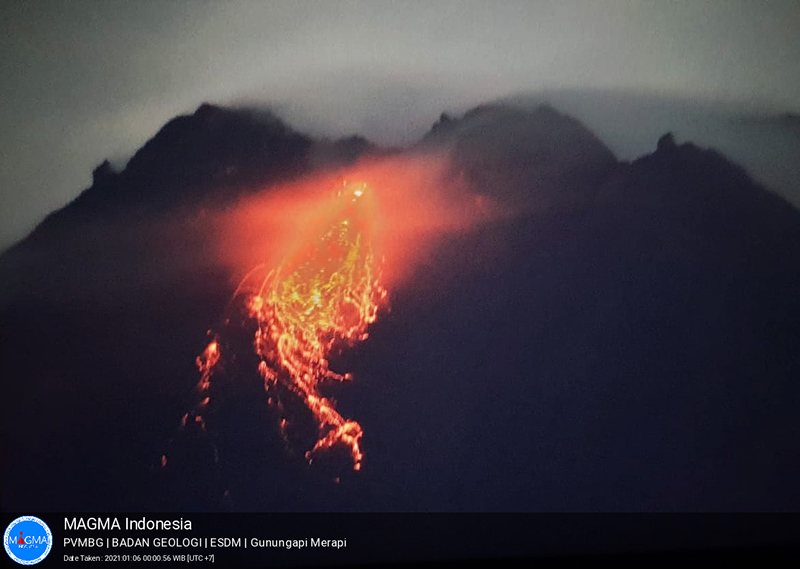 |
Figure 102. Numerous incandescent blocks fell down the SW flank of Merapi from the new lava dome, seen here on 6 January 2021. Courtesy of BPPTKG and MAGMA Indonesia Volcano Photo Gallery. |
Incandescent block avalanches were observed 128 times during the second week of January moving as far as 900 m down the SW flank to the upper reaches of Kali Krasak. Two block-and-ash flows were also reported. On 14 January 2021, the measured volume of the new dome was 46,766 m3 with a growth rate of about 8,500 m3/day. Deformation decreased significantly to a shortening rate of 6 cm/day during the second week of the month. Incandescent avalanches continued at a high rate and were reported 282 times during the third week of January (figure 103); they traveled as far as 1,000 m to the upper reaches of the Kali Krasak and Kali Boyong. Block-and-ash flows were recorded 19 times during 15-21 January moving 1,800 m downslope to the SW (figure 104). Compared to the previous week, as measured on 21 January, the new dome had more than doubled in size to 104,000 m3 with an average growth rate of 8,600 m3/day.
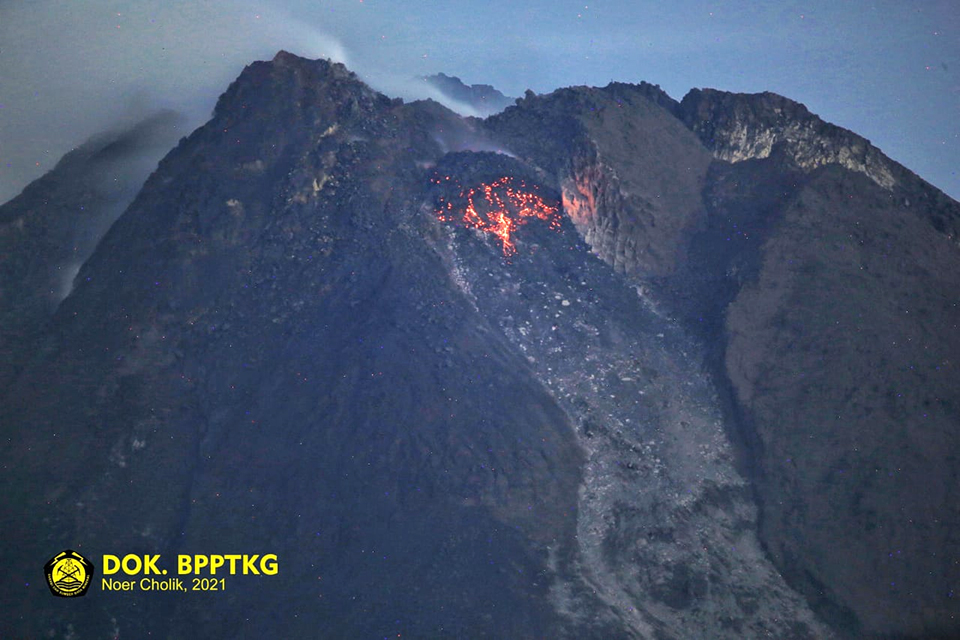 |
Figure 103. There were 20 incandescent block avalanches that fell up to 1,000 m down the SW flank of Merapi from the new dome on 16 January 2021. Courtesy of BPPTKG. |
The deformation rate decreased further to less than 1 cm/day by the end of the third week of January. A substantial block-and-ash flow on 19 January that moved 1,800 m down the Krasak and Boyong rivers produced a 500-m-high ash plume that drifted E. According to detikNews, ash fell on 19 January in several villages in Musuk and Tamansari Districts in the Boyolali Regency, and in the Kemalang District in the Klaten Regency (figure 105). The Darwin VAAC reported ash visible in the webcam on 20 and 26 January that drifted downwind close to the summit. Over 200 incandescent block avalanches were observed during the last week of January; the maximum distance traveled was 1,500 m down the SW flank. Block-and-ash flow activity increased significantly during 25-27 January with four flows on 25 January and 13 flows on 26 January which produced ash plumes that rose 300-400 m above the summit and traveled 600-1,500 m down the SW flank. PVMBG reported 31 block-and-ash flows on 27 January that traveled as far as 3 km down the SW flank (figure 106).
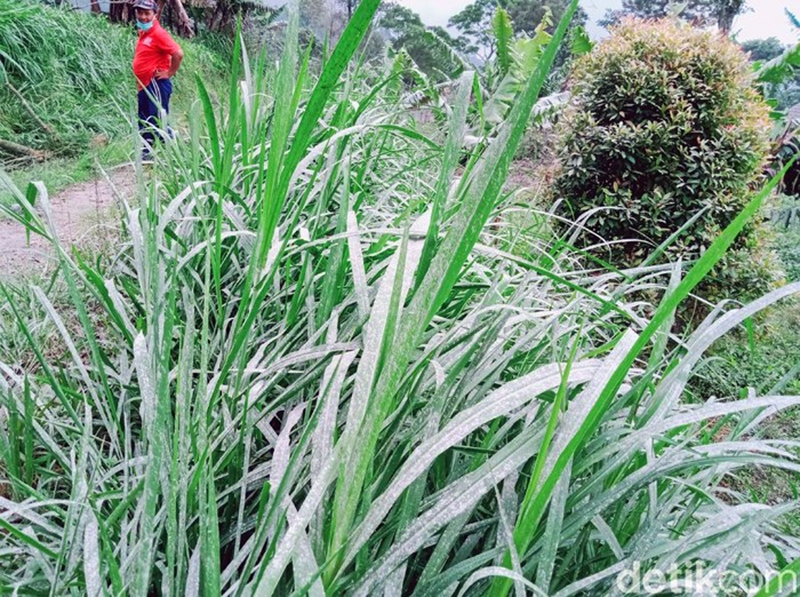 |
Figure 105. Ash from Merapi covered plants in Tegalmulyo Village, in the Klaten Regency on 19 January 2021. Photo by Achmad Syauqi, courtesy of detik.com. |
The volume of the 2021 lava dome on 25 January 2021 was 157,000 m3, but by 28 January it was only 62,000 m3 as a result of block-and-ash flows, explosions, and pyroclastic flows that occurred on 26-27 January. An explosion on 27 January was reported by the Darwin VAAC, based on multiple ground reports of a significant eruption, although meteoric clouds obscured most ground observations. The ash plume rose to 12.2 km altitude, drifted NW, and was visible in satellite images. Ash emissions from a superheated pyroclastic flow rose to 6.1 km altitude and drifted NE (figure 107). Satellite imagery and pilot reports indicated that the 12.2 km ash plume dissipated after about five hours, while the plumes generated by the pyroclastic flow continued moving E at 3.7 km altitude for several more hours. Sand-sized ash was reported in several villages in the Tamansari District in Boyolali Regency on the E flank including the Dukuh Beling area, Sudimoro (Sangup Village), Lanjaran Village, Mriyan and in Boyolali City, Central Java on 27 January. Dense ash was also reported in Tegalmulyo Village; Sruni Village and Cluntang in the Musuk District also reported ashfall.
Multiple incandescent rock avalanches were observed during the first week of February 2021. They traveled 500-1,200 m down the SW flank. On 4 February the volume of the 2021 lava dome on the SW flank was measured at 117,400 m3; the growth rate since 28 January was 12,600 m3/day. On 8 February, 23 incandescent block avalanches were reported that traveled as far as 1,500 m from the summit down the SW flank upstream of Kali Krasak and Kali Boyong. Six incandescent avalanches were reported on 9 February; webcams indicated multiple daily incandescent block avalanches for the rest of the month. When measured on 11 February, the dome had grown significantly to 295,000 m3 at a growth rate of 48,900 m3/day (figure 108).
A drone observation on 17 February noted two lava domes at the summit. The first (the 2021 lava dome) was located on the SW flank and was attached to the 1997 lava dome, and a second new dome had appeared more in the center of the summit crater. Based on calculations from aerial photographs, the dome on the SW flank was 258 m long, 133 m wide, and 30 m high, with a volume of 397,500 m3 and growth rate of 25,200 m3/day. The lava dome in the center of the summit crater was 160 m long, 120 m wide, and 50 m high, with a volume of 426,000 m3 and an average growth rate of 10,000 m3/day. Deformation data showed no changes during February. During 24-27 February one or two block-and-ash flows occurred each day, the largest travelled 1,900 m SW (figure 109). The block-and-ash flow on 25 February 2021 at 1652 local time (WIB) produced traces of ashfall in Kali Tengah Lor, Kali Tengah Kidul, Deles, and Tlukan. The volume of the lava dome on the SW flank on 25 February was 618,700 m3 with a growth rate of 13,600 m3/day.
Geological Summary. Merapi, one of Indonesia's most active volcanoes, lies in one of the world's most densely populated areas and dominates the landscape immediately north of the major city of Yogyakarta. It is the youngest and southernmost of a volcanic chain extending NNW to Ungaran volcano. Growth of Old Merapi during the Pleistocene ended with major edifice collapse perhaps about 2,000 years ago, leaving a large arcuate scarp cutting the eroded older Batulawang volcano. Subsequent growth of the steep-sided Young Merapi edifice, its upper part unvegetated due to frequent activity, began SW of the earlier collapse scarp. Pyroclastic flows and lahars accompanying growth and collapse of the steep-sided active summit lava dome have devastated cultivated lands on the western-to-southern flanks and caused many fatalities.
Information Contacts: Pusat Vulkanologi dan Mitigasi Bencana Geologi (PVMBG, also known as Indonesian Center for Volcanology and Geological Hazard Mitigation, CVGHM), Jalan Diponegoro 57, Bandung 40122, Indonesia (URL: http://www.vsi.esdm.go.id/); MAGMA Indonesia, Kementerian Energi dan Sumber Daya Mineral (URL: https://magma.esdm.go.id/v1, https://magma.esdm.go.id/v1/gunung-api/gallery); Sentinel Hub Playground (URL: https://www.sentinel-hub.com/explore/sentinel-playground); Balai Penyelidikan dan Pengembangan Teknologi Kebencanaan Geologi (BPPTKG), Center for Research and Development of Geological Disaster Technology (URL: http://merapi.bgl.esdm.go.id/, https://twitter.com/BPPTKG/status/1350508928740675584); Badan Nasional Penanggulangan Bencana (BNPB), National Disaster Management Agency, Graha BNPB - Jl. Scout Kav.38, East Jakarta 13120, Indonesia (URL: http://www.bnpb.go.id/); Darwin Volcanic Ash Advisory Centre (VAAC), Bureau of Meteorology, Northern Territory Regional Office, PO Box 40050, Casuarina, NT 0811, Australia (URL: http://www.bom.gov.au/info/vaac/); Detik news (URL: https://news.detik.com/, https://news.detik.com/berita-jawa-tengah/d-5339832/hujan-abu-gunung-merapi-jangkau-desa-di-wilayah-krb-ii-klaten, https://news.detik.com/berita-jawa-tengah/d-5350542/gunung-merapi-erupsi-sirene-bahaya-meraung-warga-turun-ke-tempat-aman, https://news.detik.com/berita-jawa-tengah/d-5350625/gunung-merapi-erupsi-besar-boyolali-diguyur-hujan-abu-campur-pasir?_ga=2.230047007.2076450499.1612195171-14950811.1611700211); Rizal (URL: https://twitter.com/Rizal06691023/status/1360488059649757191).


